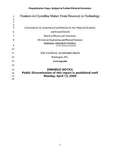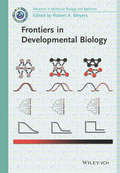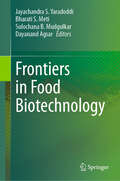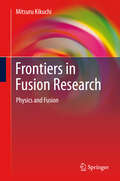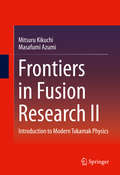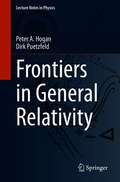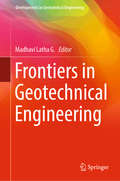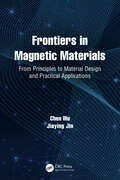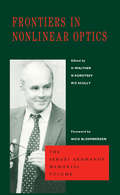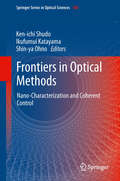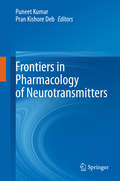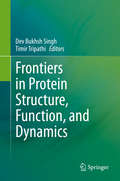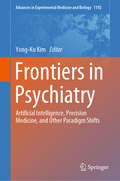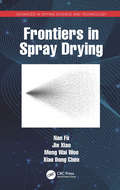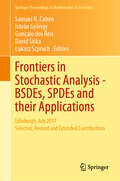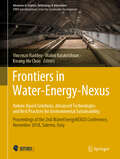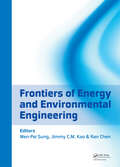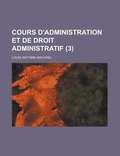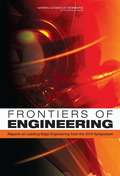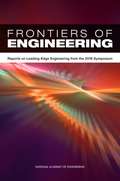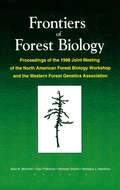- Table View
- List View
Frontiers in Crystalline Matter: From Discovery to Technology
by National Research Council of the National AcademiesFor much of the past 60 years, the U.S. research community dominated the discovery of new crystalline materials and the growth of large single crystals, placing the country at the forefront of fundamental advances in condensed-matter sciences and fueling the development of many of the new technologies at the core of U.S. economic growth. The opportunities offered by future developments in this field remain as promising as the achievements of the past. However, the past 20 years have seen a substantial deterioration in the United States' capability to pursue those opportunities at a time when several European and Asian countries have significantly increased investments in developing their own capacities in these areas. This book seeks both to set out the challenges and opportunities facing those who discover new crystalline materials and grow large crystals and to chart a way for the United States to reinvigorate its efforts and thereby return to a position of leadership in this field.
Frontiers in Developmental Biology (Current Topics from the Encyclopedia of Molecular Cell Biology and Molecular Medicine)
by Robert A. MeyersThis topical volume in the respected Encyclopedia series is the first in many years to bring together all important aspects of developmental biology in one source, from morphogenesis and organogenesis, via epigenetic regulation of gene expression to evolutionary developmental biology. The editor-in-chief has assembled an outstanding team of contributors to review these topics, creating an authoritative work for many years to come. The result is a unique, top-level reference in developmental biology for researchers, students and professionals alike.
Frontiers in Food Biotechnology
by Jayachandra S. Yaradoddi Bharati S. Meti Sulochana B. Mudgulkar Dayanand AgsarThis is a great book to explore the science underlying the Food Biotechnology, which explores and presents current biotechnological advances and approaches to improving the nutritional value of modern-foods. Novel fermentation and enzyme technological processes, protein engineering, genetic engineering, metabolic engineering, bioengineering, quorum sensing and nanobiotechnology have been incorporated to fetch into new dimensions in current food biotechnology research and this book provides a deep insight on all these aspects as a comprehensive resource for anybody interested in all the types of foods, latest processing, preservation technology and safety. Written by leading scientists in the field, the book will be a valuable resource for students and researchers in the fields of food chemistry, nutritional science, taste physiology, and neuroscience, as well as for professionals in the food industry.
Frontiers in Fusion Research
by Mitsuru KikuchiFrontiers in Fusion Research provides a systematic overview of the latest physical principles of fusion and plasma confinement. It is primarily devoted to the principle of magnetic plasma confinement, that has been systematized through 50 years of fusion research. Frontiers in Fusion Research begins with an introduction to the study of plasma, discussing the astronomical birth of hydrogen energy and the beginnings of human attempts to harness the Sun's energy for use on Earth. It moves on to chapters that cover a variety of topics such as: * charged particle motion, * plasma kinetic theory, * wave dynamics, * force equilibrium, and * plasma turbulence. The final part of the book describes the characteristics of fusion as a source of energy and examines the current status of this particular field of research. Anyone with a grasp of basic quantum and analytical mechanics, especially physicists and researchers from a range of different backgrounds, may find Frontiers in Fusion Research an interesting and informative guide to the physics of magnetic confinement.
Frontiers in Fusion Research II
by Mitsuru Kikuchi Masafumi AzumiThis book reviews recent progress in our understanding of tokamak physics related to steady state operation, and addresses the scientific feasibility of a steady state tokamak fusion power system. It covers the physical principles behind continuous tokamak operation and details the challenges remaining and new lines of research towards the realization of such a system. Following a short introduction to tokamak physics and the fundamentals of steady state operation, later chapters cover parallel and perpendicular transport in tokamaks, MHD instabilities in advanced tokamak regimes, control issues, and SOL and divertor plasmas. A final chapter reviews key enabling technologies for steady state reactors, including negative ion source and NBI systems, Gyrotron and ECRF systems, superconductor and magnet systems, and structural materials for reactors. The tokamak has demonstrated an excellent plasma confinement capability with its symmetry, but has an intrinsic drawback with its pulsed operation with inductive operation. Efforts have been made over the last 20 years to realize steady state operation, most promisingly utilizing bootstrap current. Frontiers in Fusion Research II: Introduction to Modern Tokamak Physics will be of interest to graduate students and researchers involved in all aspects of tokamak science and technology.
Frontiers in General Relativity (Lecture Notes in Physics #984)
by Dirk Puetzfeld Peter A. HoganThis book discusses some of the open questions addressed by researchers in general relativity. Photons and particles play important roles in the theoretical framework, since they are involved in analyzing and measuring gravitational fields and in constructing mathematical models of gravitational fields of various types. The authors highlight this aspect covering topics such as the construction of models of Bateman electromagnetic waves and analogous gravitational waves, the studies of gravitational radiation in presence of a cosmological constant and the gravitational compass or clock compass for providing an operational way of measuring a gravitational field. The book is meant for advanced students and young researchers in general relativity, who look for an updated text which covers in depth the calculations and, equally, takes on new challenges. The reader, along the learning path, is stimulated by provocative examples interspersed in the text that help to find novel representations of the uses of particles and photons.
Frontiers in Geotechnical Engineering (Developments in Geotechnical Engineering)
by Madhavi Latha G.This volume contains contributions by eminent researchers in the field of geotechnical engineering. The chapters of this book are based on the keynote and theme lectures delivered at the Indian Geotechnical Conference 2018, and discuss the recent issues and challenges, while providing perspective on the possible solutions and future directions. A strong emphasis is placed on proving connections between academic research and field practice, with many examples and case studies. Topics covered in this volume include contemporary infrastructural challenges, underground space utilization, sustainable construction, dealing with problematic soils and situations and geo-environmental issues including landfills. This book will be of interest to researchers, practitioners and students alike.
Frontiers in Magnetic Materials: From Principles to Material Design and Practical Applications
by Chen Wu Jiaying JinThe book aims to provide comprehensive and practical guidance on magnetism and magnetic materials. It involves four parts, focusing on fundamental magnetism, hard magnetic materials, soft magnetic materials and other functional magnetic materials. Part I highlights the ubiquity of magnetism and the close relationships between magnetic materials and our daily life. Perspectives on magnetism from Engineering and Physics are provided to introduce the two unit systems, followed by the origin and categories of magnetisms. An introduction of important parameters during magnetization and magnetic measurement techniques are then provided to lay a solid foundation for the readers for better understandings of the design and development of different magnetic materials. Important magnetic materials are then introduced in the subsequent parts, delivering an overview of design principles, production technologies, research developments and real-world applications. For instance, rare-earth-free and rare-earth-based hard magnetic materials as well as soft magnetic materials such as Fe-based alloys, composites and ferrites are discussed. Other functional magnetic materials span a wide range, involving smart materials with magneto-X effects, together with magnetic materials for applications including electromagnetic wave absorption, biomedicine and catalysis, etc. For these magnetic materials, more emphasis is placed on the latest advances and interdisciplinary perspectives.
Frontiers in Nonlinear Optics, The Sergei Akhmanov Memorial Volume: The Sergei Akhmanov Memorial Volume
by H. Walther N. Koroteev M.O. ScullyIn tribute to the memory of Sergei Akhmanov, a pioneer in the field, Frontiers in Nonlinear Optics presents an overview of quantum electronics and nonlinear optics. The contributors, world leaders in this field, provide up-to-date surveys and current trends to ensure comprehensive coverage in all aspects of nonlinear optics. This fascinating collection is necessary reading both for researchers entering the field and for established researchers in nonlinear optics.
Frontiers in Optical Methods
by Ken-Ichi Shudo Ikufumui Katayama Shin-Ya OhnoThis collection of reviews by leading Japanese researchers covers topics like ultrafast optical responses, terahertz and phonon studies, super-sensitive surface and high-pressure spectroscopy, combination of visible and x-ray photonics. Several related areas at the cutting edge of measurement technology and materials science are included. This book is partly based on well-cited review articles in the Japanese language in special volumes of the Journal of the Vacuum Society of Japan.
Frontiers in Pharmacology of Neurotransmitters
by Puneet Kumar Pran Kishore DebNumerous phenomenal advances have been made towards understanding the role of neurotransmitters in the pathophysiology of neurological disorders, and these have resulted in a large number of novel molecules with the potential to revolutionize the treatment and prevention of such disorders. This book provides a comprehensive and detailed explanation of brain neurotransmitters and their receptors and associated channels. It includes a basic introduction, and also discusses the functions and recent advances and their pharmacology, highlighting the role of various computer aided drug design (CADD) strategies for the development of therapeutic ligands to modulate these receptors/ion channels. Written in an easy-to-read style, it is intended for neuroscience and pharmaceutical students and researchers working in the area of brain neurotransmitters.
Frontiers in Protein Structure, Function, and Dynamics
by Dev Bukhsh Singh Timir TripathiThis book discusses a broad range of basic and advanced topics in the field of protein structure, function, folding, flexibility, and dynamics. Starting with a basic introduction to protein purification, estimation, storage, and its effect on the protein structure, function, and dynamics, it also discusses various experimental and computational structure determination approaches; the importance of molecular interactions and water in protein stability, folding and dynamics; kinetic and thermodynamic parameters associated with protein-ligand binding; single molecule techniques and their applications in studying protein folding and aggregation; protein quality control; the role of amino acid sequence in protein aggregation; muscarinic acetylcholine receptors, antimuscarinic drugs, and their clinical significances. Further, the book explains the current understanding on the therapeutic importance of the enzyme dopamine beta hydroxylase; structural dynamics and motions in molecular motors; role of cathepsins in controlling degradation of extracellular matrix during disease states; and the important structure-function relationship of iron-binding proteins, ferritins. Overall, the book is an important guide and a comprehensive resource for understanding protein structure, function, dynamics, and interaction.
Frontiers in Psychiatry: Artificial Intelligence, Precision Medicine, and Other Paradigm Shifts (Advances in Experimental Medicine and Biology #1192)
by Yong-Ku KimThis book reviews key recent advances and new frontiers within psychiatric research and clinical practice. These advances either represent or are enabling paradigm shifts in the discipline and are influencing how we observe, derive and test hypotheses, and intervene. Progress in information technology is allowing the collection of scattered, fragmented data and the discovery of hidden meanings from stored data, and the impacts on psychiatry are fully explored. Detailed attention is also paid to the applications of artificial intelligence, machine learning, and data science technology in psychiatry and to their role in the development of new hypotheses, which in turn promise to lead to new discoveries and treatments. Emerging research methods for precision medicine are discussed, as are a variety of novel theoretical frameworks for research, such as theoretical psychiatry, the developmental approach to the definition of psychopathology, and the theory of constructed emotion. The concluding section considers novel interventions and treatment avenues, including psychobiotics, the use of neuromodulation to augment cognitive control of emotion, and the role of the telomere-telomerase system in psychopharmacological interventions.
Frontiers in Quantum Methods and Applications in Chemistry and Physics
by M.A.C. Nascimento Jean Maruani Erkki J. Brändas Gerardo Delgado-BarrioThis edited, multi-author volume contains 14 selected, peer-reviewed contributions based on the presentations given at the 18th International Workshop on Quantum Systems in Chemistry, Physics, and Biology (QSCP XVIII), held at Casa da Cultura de Paraty, Rio de Janeiro, Brazil, in December 2013. It is divided into several sections written by leaders in the respective fields of quantum methodology applied to atomic molecular and condensed matter systems, each containing the most relevant material based on related topics. Recent advances and state-of-the-art developments in the quantum theory of atomic, molecular and condensed matter systems (including bio and nano structures) are presented.
Frontiers in Soil and Environmental Microbiology
by Bibhuti Bhusan Mishra Suraja Kumar NayakSoil harbours a wide range of microorganisms with biotic potentials which can be explored for social benefits. The book Frontiers in Soil and Environmental Microbiology comprises an overview of the complex inter-relationship between beneficial soil microbes and crop plants, and highlights the potential for utilisation to enhance crop productivity, bioremediation and soil health. The book focusses on important areas of research such as biocide production, pesticide degradation and detoxification, microbial decay processes, remediation of soils contaminated with toxic metals, industrial wastes, and hydrocarbon pollutants. Features Presents the state of the art of microbial research in environmental and soil microbiology Discusses an integrated and systematic compilation of microbes in the soil environment and its role in agriculture and plant growth and productivity Elucidates microbial application in environmental remediation Explores advanced genomics topics for uncultivable microbes of soil
Frontiers in Spray Drying (Advances in Drying Science and Technology)
by Jie Xiao Meng Wai Woo Nan Fu Xiao Dong ChenThis book covers the latest developments and advances in spray drying and describes how they impact the basic aspect of designing and operating spray dryers. This generic approach allows users to understand how different basic aspects of spray drying have advanced. Users will learn how to apply these advances in their own specific spray drying applications. This book also discusses the handling and control of spray dried products. Includes the latest techniques for use in the design and operation of spray drying operations Covers the basic operations of spray drying that can be applied to different applications of spray drying Discusses the handling and control of spray dried product qualities from a general approach, allowing readers to tailor these approaches to their own specific products This book is aimed at professionals, researchers, and academics working in the fields of food, chemical, pharmaceutical, and industrial engineering.
Frontiers in Stochastic Analysis–BSDEs, SPDEs and their Applications: Edinburgh, July 2017 Selected, Revised and Extended Contributions (Springer Proceedings in Mathematics & Statistics #289)
by Samuel N. Cohen István Gyöngy Gonҫalo Dos Reis David Siska Łukasz SzpruchThis collection of selected, revised and extended contributions resulted from a Workshop on BSDEs, SPDEs and their Applications that took place in Edinburgh, Scotland, July 2017 and included the 8th World Symposium on BSDEs. The volume addresses recent advances involving backward stochastic differential equations (BSDEs) and stochastic partial differential equations (SPDEs). These equations are of fundamental importance in modelling of biological, physical and economic systems, and underpin many problems in control of random systems, mathematical finance, stochastic filtering and data assimilation. The papers in this volume seek to understand these equations, and to use them to build our understanding in other areas of mathematics.This volume will be of interest to those working at the forefront of modern probability theory, both established researchers and graduate students.
Frontiers in Water-Energy-Nexus—Nature-Based Solutions, Advanced Technologies and Best Practices for Environmental Sustainability: Proceedings of the 2nd WaterEnergyNEXUS Conference, November 2018, Salerno, Italy (Advances in Science, Technology & Innovation)
by Vincenzo Naddeo Malini Balakrishnan Kwang-Ho ChooThis volume includes selected contributions presented during the 2nd edition of the international conference on WaterEnergyNEXUS which was held in Salerno, Italy in November 2018. This conference was organized by the Sanitary Environmental Engineering Division (SEED) of the University of Salerno (Italy) in cooperation with Advanced Institute of Water Industry at Kyungpook National University (Korea) and with The Energy and Resources Institute, TERI (India). The initiative received the patronage of UNESCO – World Water Association Programme (WWAP) and of the International Water Association (IWA) and was organized with the support of Springer (MENA Publishing Program), Arab Water Council (AWC), Korean Society of Environmental Engineering (KSEE) and Italian Society of Sanitary Environmental Engineering Professors (GITISA). With the support of international experts invited as plenary and keynote speakers, the conference aimed to give a platform for Euro-Mediterranean countries to share and discuss key topics on such water-energy issues through the presentation of nature-based solutions, advanced technologies and best practices for a more sustainable environment. This volume gives a general and brief overview on current research focusing on emerging Water-Energy-Nexus issues and challenges and its potential applications to a variety of environmental problems that are impacting the Euro-Mediterranean zone and surrounding regions. A selection of novel and alternative solutions applied worldwide are included. The volume contains over about one hundred carefully refereed contributions from 44 countries worldwide selected for the conference. Topics covered include (1) Nexus framework and governance, (2) Environmental solutions for the sustainable development of the water sector, (3) future clean energy technologies and systems under water constraints, (4) environmental engineering and management, (5) Implementation and best practices Intended for researchers in environmental engineering, environmental science, chemistry, and civil engineering. This volume is also an invaluable guide for industry professionals working in both water and energy sectors.
Frontiers of Astrobiology
by Chris Impey Jonathan Lunine José FunesAstrobiology is an exciting interdisciplinary field that seeks to answer one of the most important and profound questions: are we alone? In this volume, leading international experts explore the frontiers of astrobiology, investigating the latest research questions that will fascinate a wide interdisciplinary audience at all levels. What is the earliest evidence for life on Earth? Where are the most likely sites for life in the Solar System? Could life have evolved elsewhere in the Galaxy? What are the best strategies for detecting intelligent extraterrestrial life? How many habitable or Earth-like exoplanets are there? Progress in astrobiology over the past decade has been rapid and, with evidence accumulating that Mars once hosted standing bodies of liquid water, the discovery of over 500 exoplanets and new insights into how life began on Earth, the scientific search for our origins and place in the cosmos continues.
Frontiers of Energy and Environmental Engineering
by Ran Chen Jimmy C.M. Kao Wen-Pei SungFrontiers of Energy and Environmental Engineering brings together 192 peer-reviewed papers presented at the 2012 International Conference on Frontiers of Energy and Environment Engineering, held in Hong Kong, December 11-13, 2012. The aim of the conference was to provide a platform for researchers, engineers and academics as well as industry profes
Frontiers of Engineering
by National Academy of EngineeringCe livre historique peut contenir de nombreuses coquilles et du texte manquant. Les acheteurs peuvent generalement telecharger une copie gratuite scannee du livre original (sans les coquilles) aupres de lediteur. Non reference. Non illustre. 1856 edition. Extrait: . . . separe, une quantite de tetes de betail proportionnee a letendue de lexploitation, et suivant les dispositions des regles que je vous ai ci-dessus tracees. (Art. 15. ) IV. Quelques precautions ont ete prises enfin par la loi, pour proteger les cultures et les recoltes contre les abus journaliers du parcours et de la vaine pature. 1 Dans aucun cas, et dans aucun temps, ces droits ne peuvent sexercer sur les prairies artificielles, et ne peuvent avoir lieu sur aucune terre ensemencee ou couverte de quelques productions que ce soit, quapres la recolte. (. , art. 9. ) 2 Partout ou les prairies naturelles sont sujettes au parcours ou a la vaine pature, ils nont lieu que dans le temps autorise par les lois et coutumes, et jamais tant que la premiere herbe nest pas recoltee. (Ib. , art. 10. ) 3 Enfin, dans les lieux de parcours ou de vaine pature, comme dans ceux ou ces usages ne sont pas etablis, les patres et les bergers ne peuvent mener les troupeaux daucune espece dans les champs moissonnes et ouverts, que deux jours apres la recolte entiere, sous peine dune amende de la valeur dune journee de travail: lamende est double si les bestiaux ont penetre dans un enclos rural. (Art. 22. ) Cette suspension de lintroduction du betail dans les champs cultives a surtout ete etablie dans linteret du glanage et des malheureux pour lesquels il est une precieuse ressource. V. 11 fallait enfin coordonner les regles du parcours et de la vaine pature avec. . .
Frontiers of Engineering: Reports on Leading-Edge Engineering from the 2010 Symposium
by National Academy of Engineering of the National AcademiesThis volume highlights the papers presented at the National Academy of Engineering's 2010 U.S. Frontiers of Engineering Symposium. Every year, the symposium brings together 100 outstanding young leaders in engineering to share their cutting-edge research and technical work. The 2010 symposium was held September 23 - 25, and hosted by IBM at the IBM Learning Center in Armonk, New York. Speakers were asked to prepare extended summaries of their presentations, which are reprinted here. The intent of this book is to convey the excitement of this unique meeting and to highlight cutting-edge developments in engineering research and technical work.
Frontiers of Engineering: Reports on Leading-Edge Engineering from the 2015 Symposium
by National Academy of EngineeringThis volume presents papers on the topics covered at the National Academy of Engineering's 2015 US Frontiers of Engineering Symposium. Every year the symposium brings together 100 outstanding young leaders in engineering to share their cutting-edge research and innovations in selected areas. The 2015 symposium was held September 9-11 at the Arnold and Mabel Beckman center in Irvine, California. The intent of this book is to highlight innovative developments in engineering research and technical work.
Frontiers of Engineering: Reports on Leading-edge Engineering from the 2002 NAE Symposium on Frontiers of Engineering
by National Academy of Engineering StaffThis collection includes summaries of presentations given at the NAE Symposium in September 2002. Topics include chemical and molecular engineering in the 21st century, human factors engineering, the future of nuclear energy, and engineering challenges for quantum information technology.
Frontiers of Forest Biology: Proceedings of the 1998 Joint Meeting of the North American Forest Biology Workshop and the Western
by A K Mitchell Pasi Puttonen M Stoehr Barbara J HawkinsDiscover new approaches to promote a viable forest industry while protecting non-timber values!Frontiers of Forest Biology: Proceedings of the 1998 Joint Meeting of the North American Forest Biology Workshop and the Western Forest Genetics Association gives you significant new insights on current initiatives in forest biology. Because the field is changing rapidly, you need to keep aware of current trends, as the emphasis in forest research shifts from productivity-based goals to sustainable development of forest resources. In this volume, you will find a comprehensive summary of the state of the art of forest science in North America. Whether your focus is on genetics or on the environmental aspects of forest science, plant physiology, or silviculture, you will find helpful chapters by practitioners as well as cutting-edge research by scientists. This integrated approach is unique in the field. Based on the 1998 Joint Meeting of the North American Forest Biology Workshop and the Western Forest Genetics Association, Frontiers of Forest Biology addresses changing priorities in forest resource management. This important book contains fascinating research studies, complete with tables and diagrams, on topics such as biodiversity research, the productivity of commercial species, conserving adaptive variation in forest ecosystems, and the effect of harvesting trees on nutrient leaching.The book maps the frontiers of this fast-changing science with chapters on: the social, biological, and industrial context of forest biology new directions for research into genetics, physiology, plant silviculture, and conservation the impact of genetics on sustainable forestry the effects of cold and disease on plant physiology regeneration of various species after logging new species adapted for agroforestry the impact and management of exotic weedsFrontiers of Forest Biology offers solid information on a broad spectrum of topics and suggests fresh avenues for your investigations in all aspects of forest biology.
